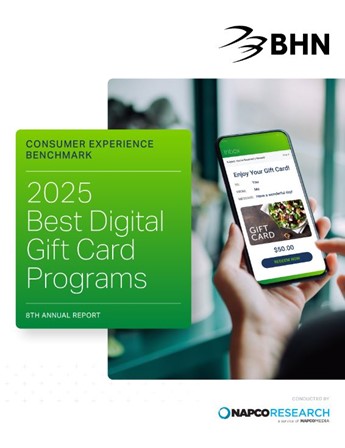
For the 18th year running, gift cards topped wish lists as the most requested holiday present—solidifying their role as a cornerstone of seasonal giving1. With more occasions to gift than ever before, demand is surging, and retailers can’t afford to miss the opportunity.
Insights from the 2025 Best Digital Gift Card Programs, Consumer Experience Benchmark Report, conducted by NAPCO research in partnership with Blackhawk Network (BHN), look at the trends behind this booming market, exploring who’s buying and why, and the retailers that are staying ahead of the curve. In this PaymentsJournal Podcast, BHN’s Sarah Kositzke, Global Research Lead and Hilary Spidaliere, Director of Product Marketing, as well as Jordan Hirschfield, Director of Prepaid at Javelin Strategy & Research discussed what leading brands are doing to keep their gift cards front and center with consumers—and how they’re using them as a powerful growth engine for their businesses.
The Gift Card Opportunity

By 2028, the gift card market is projected to hit roughly $267.3 billion, with the digital gift card segment expected to soar to $115.3 billion. Clearly, gift cards have evolved far beyond a holiday-only trend. Consumers are now snapping them up year-round, taking advantage of promotions, loyalty points, and rewards. When brands create loyalty programs that benefit both the buyer and the user, they transform gift cards into a 365-day opportunity for customer engagement.
Kositzke shared that while nearly every type of buyer purchases gift cards, the buyer demographic tends to skew male, with a strong presence among Gen Z and millennials. The findings also show that gift card purchases are more common among married individuals, or individuals in a relationship, with children at home, as well as Gen Z and millennials.
Physical cards still account for the majority of purchases, but it’s worth noting that nearly half of consumers are also buying digital gift cards.
Research from this past holiday season shows that consumers received an average of about three gift cards, with a total combined value of just over $200. When the recipient isn’t nearby, digital cards are often the preferred choice. The report also found that nearly half of all gift card buyers are opting for digital formats, which are increasingly popular for smaller purchases.
“We are seeing more of what you might call micro gifting,” Spidaliere said. “Especially as more people are remote or hybrid or have friends and family across the country, you may want to send $5 to say thinking of you or congratulating them.”
Thinking about where consumers are buying their gift cards, Physical retailers who sell multiple gift card brands remain the leading point of purchase, closely followed by the brand’s own physical stores. However, there is one generational exception: among the youngest respondents—particularly Gen Z and Gen Alpha—physical stores are the clear favorite.
When it comes to digital gift cards, “We’ve seen a lot of parents who would prefer that their kids didn’t overcharge their credit card,” added Kositzke. “That lends itself to a digital platform, because the kids just want to be able to use the card online, whether it’s gaming or shopping or whatever it might be.”
When shopping for others, the average buyer purchases around four gift cards—typically one of which is digital. However, when buying gift cards for themselves, consumers choose digital formats more frequently, with two out of four being digital.
“I think that’s a really good indicator of the progression of the market,” said Hirschfield. “It was 70% physical a couple years ago, but we’re converging on this long lasting 50/50 equilibrium between digital and physical.”
About the Research

For the latest BHN survey, NAPCO research evaluated 100 U.S. merchants across 17 industries, including department stores, fashion, entertainment, home improvement, consumer electronics, and convenience stores. The study assessed more than 120 criteria, focusing on areas such as discoverability, purchaser flexibility, faceplate design options, and payment options.

Spidaliare noted that the research expanded to include the ability to send an e-gift card via messaging apps or text, in addition to evaluating the purchasing experience via email. While email remains the primary channel for driving engagement, shifting demographics suggest that may not last. Reaching audiences in the right format is becoming increasingly important, especially for those who are unlikely to open emails—or may not even use email at all. These consumers want to discover gifts quickly, whether they’re scrolling through text messages or browsing on social media.
“We see a lot of growth right now in SMS delivery and also direct into merchant app delivery, different ways of getting the gifts into their hands that are most accessible to that recipient,” said Hirschfield. “Some of that is about training the giver on how to get the card to the recipient in the best form factor. We’re seeing movement there, and I think it’s going to continue on a pretty rapid pace.”
Brand’s Own Gift Card: 2025 Results

Staples secured the top spot this year, followed by Amazon, while Best Buy, Sephora, and Target tied for third place. Staples expanded the reach of its B2B program and increased availability across several credit card rewards programs.
“Staples had great discoverability,” said Kositzke. “Across all different devices—on a desktop, in mobile apps and on the mobile web—we were able to find the Staples cards very easily. They had an excellent mobile experience and purchase flexibility, and just an enjoyable recipient experience.”
The top ten brands in the report generally ran more gift card promotions and explored new ways to amplify both brand and merchant visibility. One of the most notable areas of improvement was mobile web usage. Leading brands made it easier for consumers to find gift cards through their apps and provided multiple options for sending them.
“All of the top ten got high scores for their app experience,” said Spidaliere. “All ten had an app with their gift card program included there. Your most loyal customers are your app users, so it’s really important to make sure gift cards are prominently available there.”
Key Takeaways to Consider
The report focuses on specific details around how merchants can build and best leverage a digital gift card program for their brand. For merchants unsure of where to start—or how to grow their own gift card efforts—Spidaliere offered a few best practices to consider:
- Feature your gift card program prominently on your website and in your app, ensuring it’s easy for customers to find and access.
- Simplify the self-use purchase path by removing unnecessary steps for consumers who are purchasing for themselves.
- Allow credit card reward points to be redeemed for your brand’s digital gift cards to help expand the program’s reach and attract a new audience.
- Protect against gift card fraud by securing the digital gift card purchase and delivery process.
“We encourage merchants to conduct a benchmark of their own program, so we’d recommend you use the criteria from this year’s study as a framework,” Spidaliere said. “Go through your own purchase and recipient experience across all your devices, determine what’s working well and anything that you need to work on.”
To read the Consumer Experience Benchmark Report: 2025 Best Digital Gift Card Programs, conducted by NAPCO Research in partnership with BHN, or to watch the webinar, click HERE.
1 NRF 2024 Holiday By the Numbers
The post The Gift Card Boom—and What’s Driving It appeared first on PaymentsJournal.

